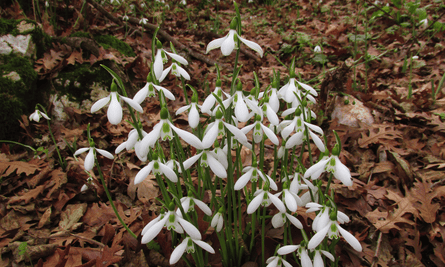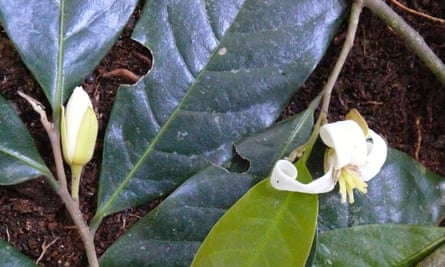A snowdrop discovered on Facebook, a miracle berry that tricks your tastebuds and a rubbery shrub that oozes its own superglue are among new plant species that were discovered in 2019.
Others identified by experts at the Royal Botanic Gardens, Kew, include a ylang-ylang tree of which just seven individuals are known to exist, a new candy-striped violet and a fungus with pink fruiting bodies that can fight cancer and viruses.
Discovering and giving scientific names to new species is the crucial first step to protecting them, the scientists said. Kew scientists officially named 102 plants and eight fungi in 2019, but many are already in danger of extinction. The major threats are the destruction of natural habitat for farmland, timber, dams and mining, as well as the impacts of the climate crisis.
Plants account for 82% of all life on Earth by weight – humans are just 0.01% – and they underpin all life, producing oxygen and food and providing shelter and medicines. There are almost 400,000 known species of plant, and about 2,000 new species are named every year.

“We all depend on plants,” said Martin Cheek, a senior botanist at Kew and who names about 10 new species a year. “It is shocking that we are still discovering so many. It is easy to think we know everything on this planet, but we don’t. The local people might know the plants, but they are unknown to science.”
“It is important to name the plants now because natural habitat is disappearing rapidly,” he said. “Only when they have a name can they have an official assessment under the International Union for Conservation of Nature, and only then do we have a chance of getting national authorities to protect those areas.”
The new snowdrop species was discovered in north-west Turkey when a paediatrician uploaded her holiday photos to Facebook, where they were spotted by a Ukrainian snowdrop specialist. The pair returned to the site and collected a sample, which was confirmed as a new species by Kew’s snowdrop expert Aaron Davis. The snowdrop has already been assessed as critically endangered.

The new miracle berry species was discovered the rainforests of the Chimanimani Mountains, on the Mozambique-Zimbabwe border. The fruits of these species contain a compound called miraculin that blocks tastebuds so that sour foods, such as limes, taste sweet. The new species is classed as endangered, due to the continuing destruction of the forest.
The rubbery shrub species was found on a single waterfall on the Bafing River in Guinea, west Africa. “They have some kind of biological superglue with which they can stick themselves to rocks to avoid being swept away, but this interesting compound hasn’t been investigated yet,” said Cheek.
Kew scientists expect the shrub to become globally extinct when construction of a hydroelectric dam begins next year. “We have examples of species from that family that have been wiped out by other hydroelectric dams,” Cheek said. Plant extinctions in general are occurring at a “frightening” rate, according to scientists, and one in five of all plants are at risk.
The rarest find in 2019 was the zonozono, a 20m-tall tree from the ylang-ylang family discovered in the Usambara Mountains of Tanzania. Just seven trees are known. The spectacular new violet family species was found in New Guinea.

The bamboo fungus from Yunnan in south-west China was only given a formal scientific name in 2019, but has been used in the region as a traditional treatment for arthritis for more than 400 years. Scientific interest is increasing due to the discovery of compounds called hypercrellins in the fungus. When exposed to light, these compounds combat tumours, viruses and other fungi.
Most new species are named after local places, but one Kew scientist took a more romantic approach. A new orange gladiolus found on top of a remote table mountain in Guinea is now called Gladiolus mariae, after Xander van der Burgt christened the plant after his wife Maria.
“It is perfectly OK if other people name a species after you,” said Cheek. “But it would be considered very bad form to name a species after yourself.”
